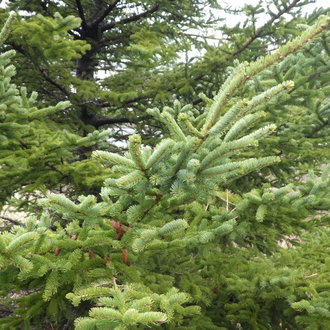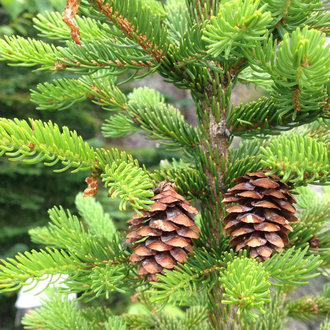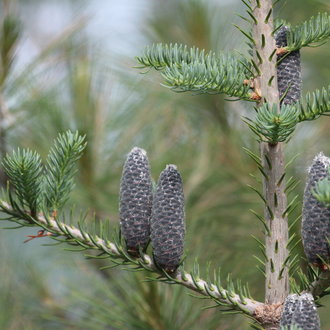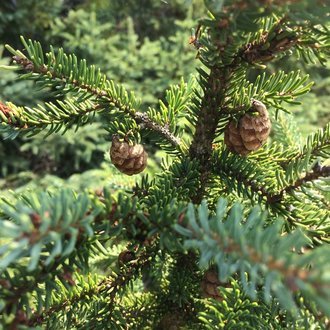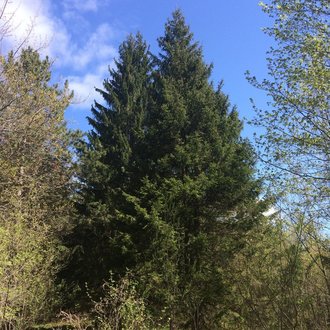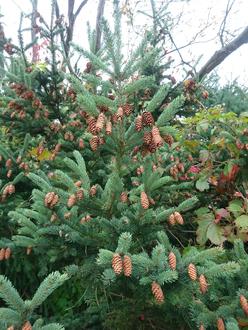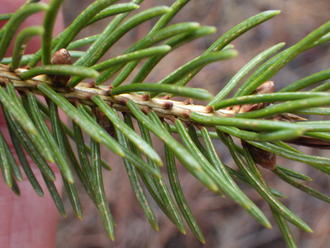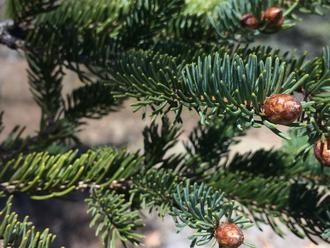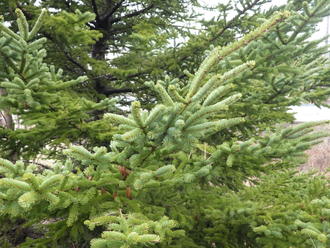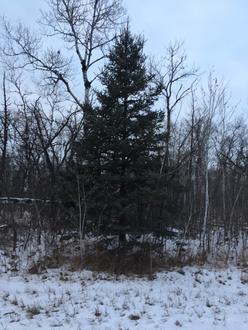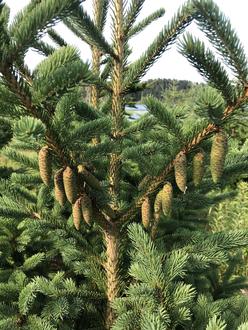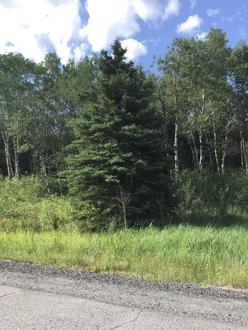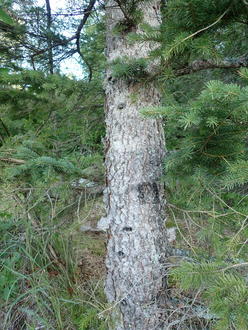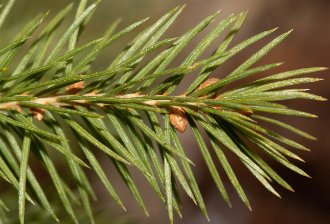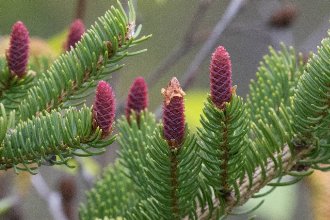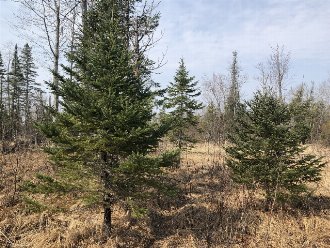White Spruce (Picea glauca (Moench) Voss)
Also classified as Picea laxa (Münchh.) Sarg.
↑Summary
A conifer native to the northernmost reaches of North America; often found on richer sites than black spruce.
↑Range - Expand
| Legend | Color |
| Native | |
| Expanded | |
| Not Present | |
| Native or Not Present | |
| Native or Expanded | |
| Expanded or Not Present | |
| Native or Expanded or Not Present |
This tentative map is based on our own research. It may have limited data on Canada and/or Mexico, and there is some subjectivity in our assignment of plants as introduced vs. expanded. Read more in this blog post.
Although this plant occurs somewhere in each of these regions, it may only occur in a small part of some or all of them.
This species is widely planted both in landscaping and in plantations for Christmas trees. It can sometimes spread into the wild, where it has established slightly south of its native range. BONAP also reports this species as found in Kentucky, but we do not. The Kentucky-Tennessee Plant Atlas does not list it, and it seems unlikely that this species could persist there long-term.
↑Similar Plants
↑Habitat
This is one of the most northerly tree species, able to survive in harsh climate conditions, and one of the first to recolonize an area following glaciation. Its range has steadily been moving northward in the interglacial period, and climate change is accelerating this move.
White spruce tends to occur on well-drained soils at lower elevations, especially in riparian areas, but can be found at higher elevations as well. Absent from poorly-drained sites, including areas where permafrost is close to the surface. Upland populations are more common on warmer south-facing slopes. Although widespread in the entire boreal region of North America, less common in the humid northeast and more common in drier areas to the west and northwest. Although not usually common in the northeast, it becomes more common along the coastline, where it often forms pure stands.
Although it is generally less common in anthropogenic habitats, in Maritime Canada and New England, it can be found in abandoned agricultural land.
In the northwest, the dominant tree at both the altitudinal and arctic treelines. At its southern range limit, usually limited to lakeshores. Even at high altitudes, often confined to areas close to rivers and streams. Tolerant of alkaline soils and some soil salinity, but less tolerant of soil acidity than black spruce. Tolerant of a wide range of soil textures, so long as the soil is adequately aerated and does not become saturated. Tolerates dry sites if the soil is sufficiently nutrient-rich.
Occurs in all stages of forest succession, but becomes more prominent in mid to late stages.
Intolerant of fire and usually killed by fire, but able to reseed into recently burned areas from nearby trees.
↑Life Cycle
White spruce is a long-lived, slow-growing tree. It typically grows slower than other associated vegetation. Seedlings are shade-tolerant, but grow faster with greater sun. Small seedlings can be smothered by organic litter and can also be out-competed by mosses and other low-growing vegetation.
Trees can produce isolated cones as young as 4 years of age, but typically do not begin producing good quantities of seed until 30 to 40 years. Trees on harsher sites, such as near the treeline, may not begin bearing cones until even older than this, and seed production may always be minimal.
Seed production is highly variable from year to year, and is influenced heavily by weather conditions. Good seed crops occur irregularly, as frequently as every other year or infrequently as every 12 years, with more favorable sites and more southerly populations tending to produce bumper crops at higher frequencies. In some years, no seed is produced.
The seeds are dispersed primarily by wind; seeds falling closer to the tree are more likely to be viable, perhaps because of being heavier. Water may also aid seed dispersal along floodplains.
Seeds falling in fall remain dormant through the winter, but seeds falling earlier sprout immediately. No seeds are stored on the trees, and seeds do not remain viable in soil beyond about a year, so there is no seed banking. Overall, even under good conditions, seed viability is low.
Germination is best in exposed mineral soil, especially that resulting from fire. However, seeds can also germanite in organic soil, rotten logs, and moss. In the absence of disturbance, rotting wood is the best medium for seedlings to establish.
Trees typically live 100 to 250 years, although they may live as long as 300 years if growing in areas protected from fire. One tree, growing north of the Arctic circle, was recorded living over 1000 years.
↑Faunal Associations
White spruce is a major component of the forests in much of its range and plays a key role in the ecosystem, with great value to animals. Mammals utilizing it for habitat include red squirrels, snowshoe hares, American martens, voles, moose, American black bear, and caribou. Numerous songbirds use it as a nesting site, as well as woodpeckers, especially black backed-woodpecker and three-toed woodpecker, and sharp-shinned hawks. The seed is a primary food source for red quirrels, and is also eaten by deer mice, northern red-backed voles, meadow voles, and shrews.
White spruce supports numerous insects. An overwhelming majority of these do not appreciably damage trees, but two can cause serious damage: the eastern spruce budworm (Choristoneura fumiferana) and the spruce beetle (Dendroctonus rufipennis).
The eastern spruce budworm has cyclical outbreaks in the east of this tree's range, occurring at intervals between 30 and 138 years; although it prefers balsam fir (Abies balsamea) as host, white spruce is also attacked, sometimes to the point of killing trees. Usually only isolated trees are killed. Infestations are driven by the density of balsam fir, and white spruce only becomes a secondary casualty of these outbreaks.
Spruce beetle outbreaks occur in the northwest of this tree's range. This beetle preferentially attacks the largest white spruce in a stand, and its outbreaks are driven by density of white spruce along with Sitka spruce and their hybrid Lutz spruce.
Outside the budworms, numerous other lepidoptera species eat white spruce, including both specialists and generalists.
↑Uses
The wood is widely used due to its availability and low price, and it is among the most important species in the Canadian forest industry. It is used for pulp, construction lumber, and crates. Higher-quality, quartersawn pieces are sometimes used for piano soundboards. The wood is easy to work with, straight-grained, and denser than most other conifers in its range, but it has only slight decay resistance. Its use in forestry is limited by its slow growth and lack of immediate reestablishment after logging, but there are methods to speed regeneration, including the leaving of isolated trees and/or mature stands to serve as seed sources.
This tree is also used as a landscaping plant, particularly in the northern US, and is planted well south of its native range. It is valued for its attractive and dense form, the distinctive slightly bluish color of its foliage, and being relatively resistant to deer browsing. However it fares poorly in urban conditions, and south of its native range it can be more demanding of good air circulation.
It is also used in windbreaks, where it is valued for its dense foliage which stops wind more effective than a number of other evergreen species.
It is also used for rehabilitation of degraded lands, especially mining sites. It is particularly well-suited to this use from Alberta through Alaska.
↑Related Plants
White spruce is closely related to other spruces with which it overlaps in range, and can naturally hybridize with them; as all spruces are closely related, hybridization is less limited by genetics and more limited by range overlap and bloom timing. It is probably closest-related to engelmann spruce (Picea engelmannii), with which it readily hybridizes.
Although it is less closely related to black spruce (Picea mariana) than black spruce is to red spruce (Picea rubens), it can still hybridize with black spruce in the wild. It does not hybridize with red spruce. It is probably even less closely related to Sitka spruce (Picea sitchensis), but still hybridizes with it readily to form the Lutz spruce (Picea ×lutzii).
Outside its genus, it is more closely related to pines, followed by larch and Douglas fir, and less closely related to true firs and hemlocks.
↑Links & External Resources
• White Spruce | The Wood Database (About This Site)
• White Spruce | Fire Effects Information System (FEIS) (About This Site)
• Picea glauca (White Spruce) | USDA PLANTS Database (About This Site)
• Picea glauca | Go Botany (About This Site)
• Picea glauca (White Spruce) | Missouri Botanical Garden Plant Finder (About This Site)
• White Spruce | Virginia Tech Dendrology Factsheets (About This Site)
• White Spruce | Silvics of North America (About This Site)
• Picea glauca | Biota of North America Project (BONAP) (About This Site)



